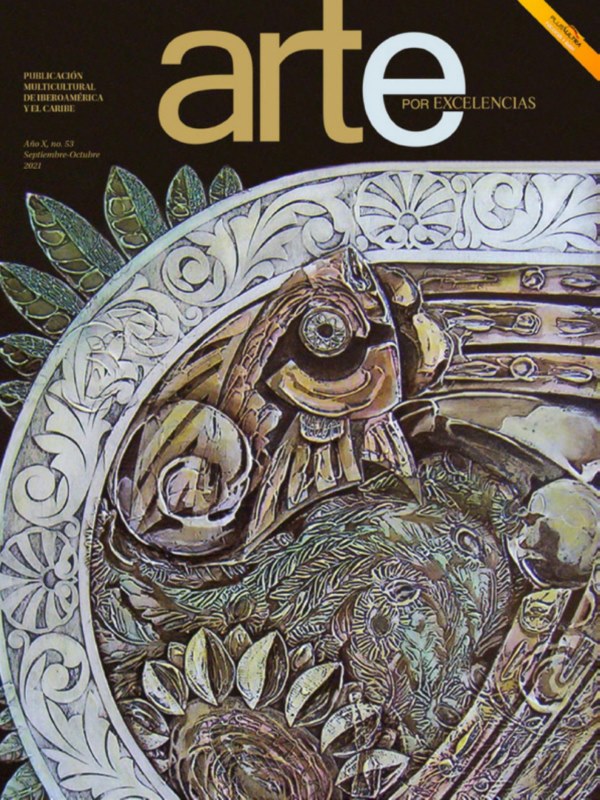In the exhibition field of the 1990s, the Caribbean was painting a non-homogeneous, yet commonly exploratory picture that was revealing itself worldwide as emerging anti-hegemony art. But at the same time, it was putting on the face of a creation capable of making cultural borderlines fade away, the same limits that had put the region on the margins of the cultural map designed by the power and ruling circles. By doing so, the Caribbean was showing off its artistic potentials as a world region. On the other hand, certain international trends toward the ethnical art, some kind of nostalgia for the primitive and the ancestral marked by an epochal sign of Les magiciens de la terre, the vindications of Africa –increasingly threatened by the perils of extinction- that sent their vibes all across this part of Africa-America1 called the Caribbean, as well as the significance of the West Indian diasporas in the U.S. and Western Europe, were all factors that started making observers turn their heads to certain areas –like this one- that had been gagged by the West’s cultural cartography. And I say so because artists, countries and major exhibits had taken shape inside and outside the region before the 1990s, yet the dynamics of that decade brought up the marking of a regional sign –the biggest highlight of all at the time. Those same international trends mentioned above, that presented themselves as opportunities for the margins, contained multiple contradictions because through their notions they were portraying misleading and faking trends leaning toward the systems of esthetic-artistic values of the south countries. The Caribbean itself, that singled out its existence as an artistic space back in the 1990s, was bound to face off these challenges once again and under new circumstances this time around. From Within It all began inside the entrails of the region. World-scope projects that popped up all at once over the past three decades set the tone and outlined a considerable chunk of the process intensity at the end of the century. Great developments like the Latin American Engraving Biennial in San Juan, Puerto Rico (1970), the Havana Biennial in Cuba (1984) and the Central American & Caribb ean Painting Biennial (1992) in Santo Domingo, Dominican Republic, panned out to be –from different perspectives and approaches- the perfect settings to put a white-heat spin on the islands’ arts, eventually cascading –I’d rather use the more tropical, refreshing and sounding word cascading, and not the more-fitting snowballing term here- into other fields. These biennials opened in times of major confrontations and dialogues among artists, critics and curators from the Caribbean, Latin America and far beyond. Other lands of the Lesser Antilles jumped on the bandwagon on a quest for meeting alternatives, like in Guadeloupe in 1991 during the local arts festival (FESTAG), that under the title name Indigo eventually evolved into a Caribbean Plastic Arts Festival from 1995 onward. These festivals helped keep this Eastern Caribbean island as a giant venue for the arts throughout an entire decade. CaribArt was held in Curacao back in 1993. Organized by the UN ESCO Netherlands Antilles National Commission, it turned out to be an unprecedented event that gathered scores of artists and art scholars from the region. In an organic fashion, this event managed to integrate the arts of all the Antilles under a selective participation concept by nations and in correspondence with their demographics. It also made theoretical and discussion room for the publishing of the book entitled “History of the Caribbean Arts” written by several authors and with major contributions from all territories. There are three biennials that came to pass in the Caribbean between the 1970s and the 90s that need to be underscored: the Latin American Engraving Biennial in San Juan, the Havana Biennial and the Central American & Caribbean Painting Biennial. When the mega-exhibits of the 20th century’s last decade were projected, over ten editions of the Latin American Engraving Biennial in Puerto Rico’s San Juan had already taken place. Even though they did encourage creation in the specific field of engraving based on the tradition that Puerto Rico had acquired in this particular expression, its repercussion was not that big in terms of insular Caribbean attendance, except for the Dominican Republic and Cuba, because the rest of the islands didn’t have a graphic movement up to par with the regional or international competitiveness. When the last decade of the past century began, the Havana Biennial had held four editions. From the very beginning, the turnout of Caribbean artists was outstanding not only in quantitative terms, but also in the number of boldface names that had already left their footprints in the Caribbean arts and helped underline some new values of the region’s plastic arts. Despite the fact that those biennials had its ups and downs in the 1990s2 , attendance of Caribbean islanders during the first four editions totaled 136 artists3 , even some of them –and this is highly important- hailing from such nations as Surinam and Guyana, whose artistic creations had remained quite unknown both within the region and overseas, with the sole exception of Casa de las Americas4 and the Caribbean Cultural Festival in Santiago de Cuba, where they joined collective exhibits. At the Fifth Havana Biennial (1994) –penciled in by the critics as an expression of the event’s conceptual maturitytwo dozen Caribbean artists displayed outstanding collections that stood tall for their contemporariness and the debut of nations like Aruba, the Bahamas and Curacao that had never before attended such world-class artistic events. A couple of other biennials took place simultaneously with the mega-events held outside the Caribbean region in those years previous to the end of the last century. In 1992, the Central America and Caribbean Painting Biennial in Santo Domingo got started, though limited to the field of painting and featuring a contest format. This event came up with a wider vision of artistic creation as it included territories other than the Caribbean islands. In their own way, each and every one of these biennials served to reenergize the region’s artistic circuits. The strength of their summoning efforts was able to either expand or shrink the Caribbean space, thus putting regional creation in different angles of the esthetic-artistic confrontation with Latin America and the Third World. Above all, the Havana Biennial, marked by more open-mindedness in terms of the trendy creations within the realm of the contemporary arts, soon became a place for Caribbean artists to rediscover themselves in the use of other possible creative methods and the assessment of the value of those new methods they were making use of. The basically thematic character of the biennials let Caribbean artists in on the fact that many of their uncertainties and interests were also shared by creators from nearby and faraway places of the world. From the Havana Biennial, networks of similarities and dissimilarities were woven. At the end of the day, they helped make the outreach of Caribbean artists much broader and safer in terms of self-confidence and their own contemporariness. The presence in these events of creators, critics, curators and both regional and international commissioners paved the way from within for the launch of projects that churned out different kinds of connections with other people in the Caribbean and acted as multiplying factors inside and outside the area during the 1990s. Outwardly Everybody’s enthusiasm was rapidly spreading over the artistic scene as a number of different initiatives kicked in. Good cases in point were the exhibits These were multiple and timely actions that tied up with one another to eventually get ingrained in the fabric of an unearthed circuit. Up to a certain degree, all these expositions were both important and different. The planning and bankrolling of these events engulfed a number of public and private institutions from the turf and other parts of the world. None of them set out to hold on to continuity, something that marked the view of them as unique and unrepeatable gatherings. However, these mega-exhibitions set the tone of the decade. Their pulse was highly intense and extremely encouraging for the arts of these islands. The experimental and exploratory action has long been an unstoppable symptom of the plastic arts in the region without causing major shakeups in the institutional platforms of teaching and promotion, even in those places where the institution-art relationship is soundly established and well recognized. Regardless of their sensitive contribution to enhancing the vision of the regional contemporary art creation for countries perched on the edges of the big-time hegemonic art centers, the persistence of esthetic-artistic stereotypes over that creation and the contradictory axes the debates hinge on when they are relocated in the internationally-acclaimed legitimizing circles also emerged. In the five abovementioned exhibits, the turnout of Caribbean artists swayed somewhere between 35 and 109 artists. That means that in a six-year term –only as far as mega-expositions are concerned- over 250 artworks by Caribbean artists, most of them hailing from the island nations- were exhibited. As it’s been said, the first of these mega-exhibits unfolded in France in 1992 under the title A New Look at the Caribbean. The curating job started out in the very Caribbean countries and though that painted a somewhat participative democratization picture6, it was also exposing a communication mesh between institutions and artistic agents on the island nations –an unprecedented fact in the history of the Caribbean arts. The catalog included the voices of critics and art historians from the countries represented there in the form of texts that suggested, in some cases, a glimpse at the first attempts to systematize artistic creation in the insular Caribbean, as seen in an article about Barbados and the small English-speaking islands. It’s interesting that the catalog’s main text proposes an exposition reading from a Creole esthetical standpoint as construed in its anthropological and cultural meaning. Between 1994 and 1995, two different kinds of mega-exhibitions took place in Germany and Miami, the former in the context of the great international exhibit Documenta. The event made such a huge splash because for the first time ever the Caribbean was putting on a regional show in an exhibition like Documenta7. And even though this artistic powwow gathered young and boldface artists alike, the exotic character –still so commonplace among European spectators- came on strong due to the prevalence of Haiti’s so-called naïf art to the detriment of showcasing a handful of current artists from that neck of the woods –something that generated a tremendous contrast in relation with the remaining participants who were very interested in displaying their own contemporary artworks. With a completely different view, the Caribbean Vision was pieced together by a team of curators from U.S. institutions in Florida, Connecticut and New Orleans. When you check out the list of participating countries, the supremacy of the linguistic criteria meets the eye –a condition that made the regional impact pulled their punches dramatically in terms of turnout. Most of the attendants were from the English-speaking West Indies and countries with mighty exiled populations in Florida, like Haiti, Puerto Rico and Cuba –in the case of Cuba, all artists but Wilfredo Lam were U.S. residents. The catalogs’ texts include the voices of Derek Walcott and Rex Nethelford, who shed substantial light on the analysis of art and cultural problems in the Caribbean. The Caribe insular, exclusión, fragmentación y paraíso (1998) exhibition turned out a very coherent and ultimate event for the Caribbean contemporary arts based on the thorough criteria for the handpicking of participating artists, the quality of the texts and the update of some of the latest creative trends. An intense effort in terms of contacts with artists and critics from those territories gave way to such an expositive newness. The century came to a close in Havana with the Mitos en el Caribe mega-exhibit organized by Casa de las Americas. This thematic exposition intended to provide a new reflection and extension of the mythical in the insular Caribbean to other fields of the contemporary social and cultural thinking, and it even managed to make artists from different Caribbean islands come together around a very original speech as far as museology and theoretical discussions are concerned. These mega-exhibitions disclose a process of international art projection of the contemporary Caribbean whose genesis was lodged in big-time regional events and that dialogued with them through a circuit of exhibits and biennials that even though they were born out of the plastic arts’ own dynamics, they also encouraged them and egged them on. They showed different aspects of that international projection of the insular Caribbean and made Caribbean art far more visible inside and outside that world region. And what did that last decade of the 20th century hand down to the projection of the insular Caribbean art for this new 10-year period? Reflection? Legend? Evocation or yearning? Don’t miss out on the upcoming chapter.









Publicaciones relacionadas

Un tejido expositivo con genuinos imaginarios
Diciembre 19, 2024
Geo Ripley: De la sombra a la luz
Diciembre 11, 2024













